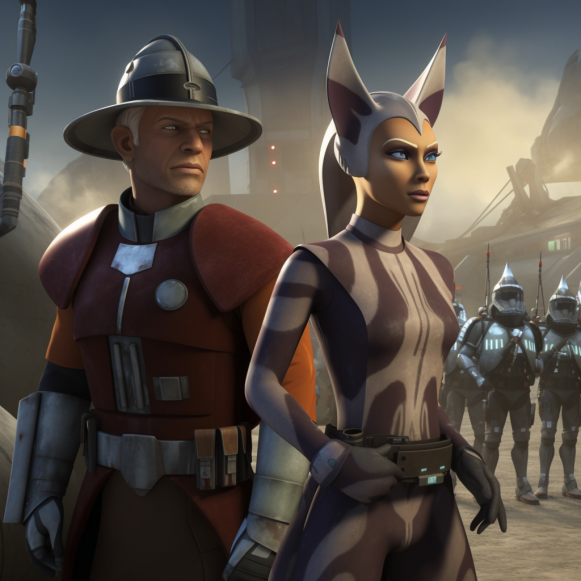Why Barbie, Star Trek, and Star Wars succeed where other movie franchises fail to capitalize on fandoms, according to a new study

Star Wars is No. 1 in a new Fandom study ranking the top 25 gaming and blockbuster franchises.
- Franchise fatigue is high, but fans still want content based on familiar characters and universes, the study found.
- It also analyzed what drives the most fan excitement, what they like about spinoffs, and more.
According to a new Fandom study, nearly three-quarters of fans (72%) are exhausted by the volume of entertainment releases, while nearly the same number (69%) prefer franchise content over new material, with Star Wars projects leading the pack.
Following Star Wars on the list of the top 25 game and TV/film franchises of 2023 are Marvel, One Piece, Elder Scrolls, and Harry Potter. The list is based on a new metric developed by the company called the Franchise Factor Score, which takes into account five factors such as degree of worldbuilding, fan and critic ratings, and cultural relevance.
An accompanying Fandom report examines which trends drive the most fan excitement, as well as fan preferences across spinoffs, adaptations, sequels, and prequels, as well as how branded tie-ins and licensing deals can keep fans excited.
According to Perkins Miller, Fandom’s CEO, the goal was to provide a unified view of what is capturing fan attention and why. “Fandom, in general, is about better serving fans.” There is so much content being created these days, and one has to wonder, “With these deca-billion-dollar content budgets, what really matters to fans?”
The study comes as major studios continue to lean into exploiting well-known characters and stories, but have struggled with execution at times. Warner Bros. Discovery CEO David Zaslav recently admitted that the company hasn’t done enough to capitalize on its intellectual property, such as DC and “Lord of the Rings,” while Disney CEO Bob Iger admitted that Marvel fatigued viewers by releasing too much content. It also comes as toy and other brands seek to emulate Barbie’s success by incorporating their products into blockbuster movies and television shows.
The research was based on a survey of 5,000 entertainment and gaming fans in the United States and the United Kingdom, as well as an examination of Fandom’s platform, which has 350 million monthly users across 250,000 fan wikis.
The study is a snapshot in time, so it won’t take into account a franchise that hasn’t released new content in a while, such as “Game of Thrones” prequel “House of the Dragon.” The study also does not consider viewership; Fandom’s argument is that by capturing fan search activity, its own site is a better reflection of their enthusiasm.
Successful franchises take time to build — 80% of the top 25 have been around for more than 20 years — and require high quality content, but the study revealed some less obvious findings about what makes strong and compelling properties.
The presence of Marvel, Harry Potter, and Barbie on the list comes as no surprise, but other top-ranked franchises, such as fantasy series “Shadow & Bone” and Nintendo action video game Zelda, were also highlighted. According to Fandom’s analysis, Nintendo won over fans by capitalizing on Zelda fans’ rabid interest in the franchise’s timeline, much like the Marvel Cinematic Universe has done, said Anthony Iaffaldano, VP, Sales Marketing & Insights at Fandom.
In addition, the top 25 list reflects the popularity of video game adaptations for film and television, such as HBO’s “The Last of Us” and Netflix’s “One Piece,” which was recently renewed for a second season. According to Netflix, the series, based on Eiichiro Oda’s manga, is the company’s No. 1 title worldwide.
According to Fandom’s research, fans valued filmed entertainment that paid homage to the depth of the original universe, including secondary storylines and characters — series and films that “translate the feeling people have playing the game,” according to Iaffaldano. He stated that 40% of cross-media adaptation fans want a strong connection to the source material.
Barbie came in sixth place on the list, with a reported budget of $145 million and extensive marketing to generate interest and participation prior to the film’s release. Fandom discovered that when Barbie social media filters and posters were released, traffic to Fandom’s Barbie wiki increased by more than 200%, outpacing the release of the movie’s trailer.
Serving original fans while attracting new ones is a difficult balance for a franchise’s growth, and the study praises Paramount+ for its curation of the Star Trek franchise, citing the successful release of the “Picard” spinoff as a nostalgia play alongside animated series “Prodigy” and “Lower Decks” aimed at new fans.
“We saw original fans far less likely to watch those,” said Iaffaldano of animated shows. “It’s been an intriguing and deliberate effort to revitalize the fan base.” Mount is one of the companies that does it well.”
Overall, 32% cited world-building, as exemplified by Star Wars, as the most important factor in franchise love. Consistency came in second (23%), followed by fanbase (18%), cultural relevance (14%), and ratings (13%).
Fandom also divided the worth of sequels, prequels, and spinoffs. It discovered that 57% of respondents preferred sequels and prequels to further explore their favorite stories and characters, while 53% preferred spinoffs to expand on the original story and characters.
Beyond having expansive universes, studios can win with fans by studying where they’re congregating and how they’re expressing their fandom, as well as knowing which franchise characters can tap into the cultural zeitgeist, according to Miller.
“We look at our fans, and they’re heavily engaged online; they’re involved in cosplay,” he explained. “Understanding where these communities live may not be as obvious to studios.”






